Analysis of Budgeting Techniques in Managerial Accounting Report
VerifiedAdded on 2023/01/11
|12
|3828
|70
Report
AI Summary
This report delves into the application of budgeting as a crucial managerial technique, drawing upon a journal article focused on the Japanese aviation industry. The report explores the budgeting process, including stages of budget creation and the purposes it serves, such as setting targets, controlling spending, and evaluating performance. It analyzes the planning, controlling, and performance evaluation aspects of budgeting, supported by the journal article's findings. The report identifies and explains the top-down budgeting practice adopted by the company, along with its behavioral implications, including functional behavior and budgetary slack. Furthermore, it critically evaluates the argument that traditional budgeting constrains creativity, and provides recommendations for contemporary organizations regarding planning and control. The report concludes with a comprehensive summary of the findings and recommendations related to effective budgeting practices.
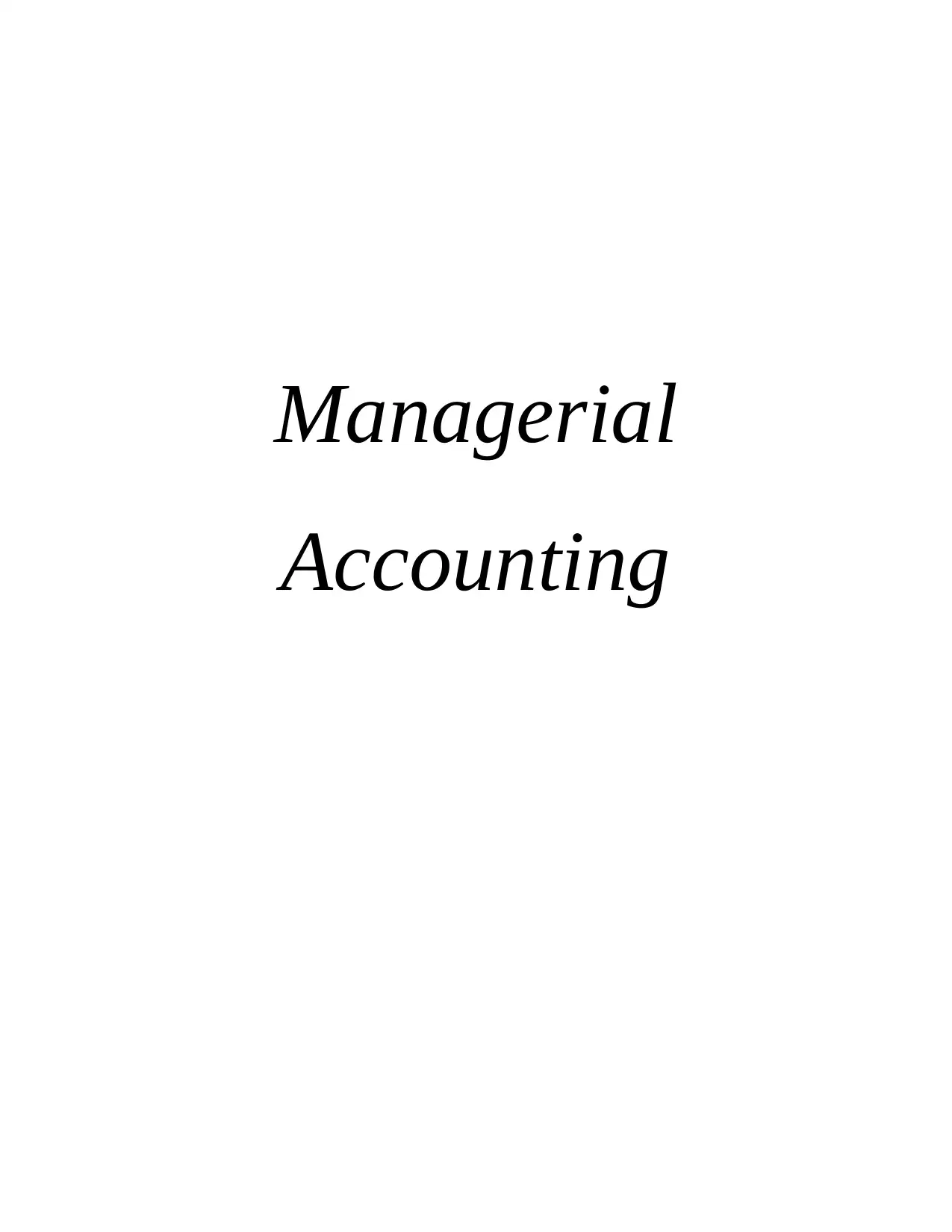
Managerial
Accounting
Accounting
Paraphrase This Document
Need a fresh take? Get an instant paraphrase of this document with our AI Paraphraser
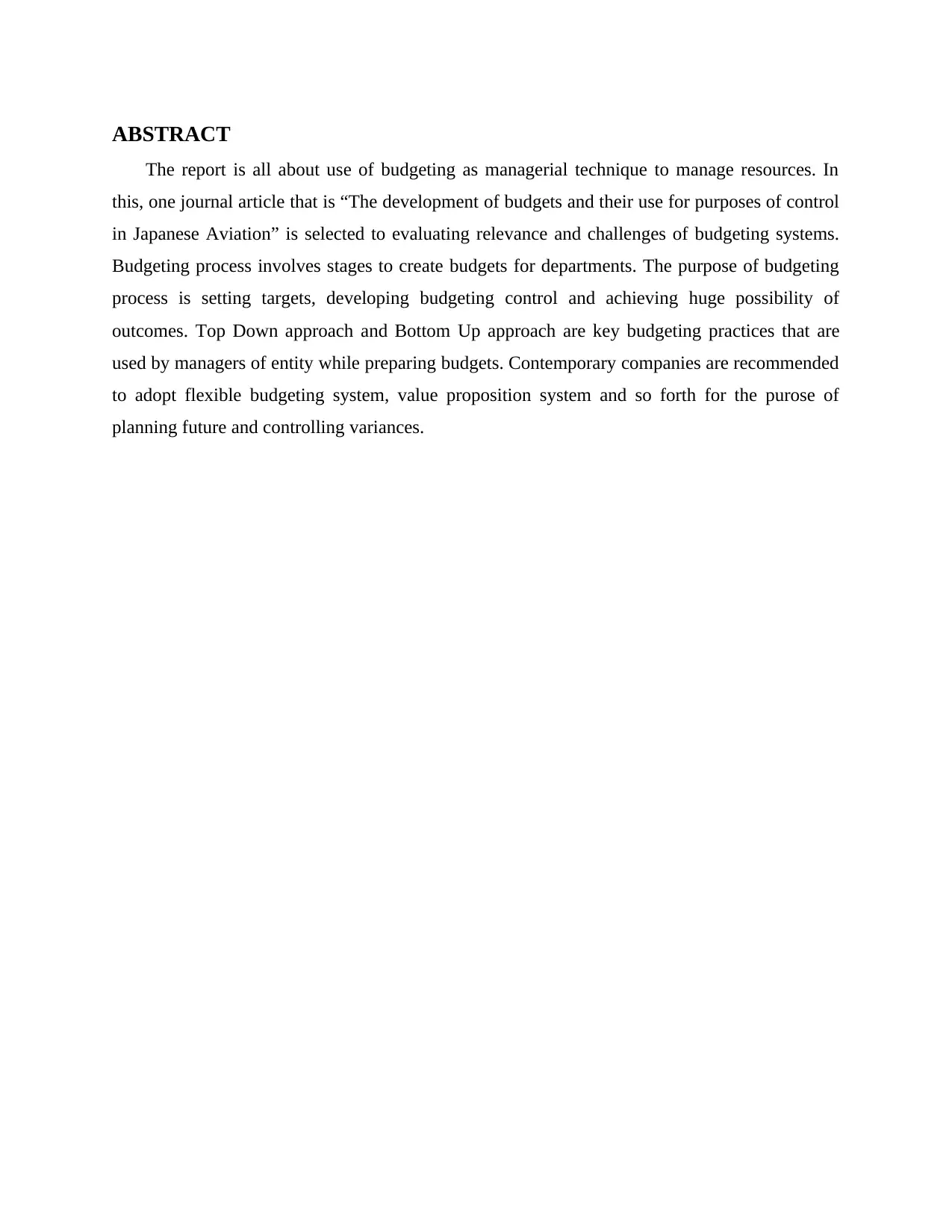
ABSTRACT
The report is all about use of budgeting as managerial technique to manage resources. In
this, one journal article that is “The development of budgets and their use for purposes of control
in Japanese Aviation” is selected to evaluating relevance and challenges of budgeting systems.
Budgeting process involves stages to create budgets for departments. The purpose of budgeting
process is setting targets, developing budgeting control and achieving huge possibility of
outcomes. Top Down approach and Bottom Up approach are key budgeting practices that are
used by managers of entity while preparing budgets. Contemporary companies are recommended
to adopt flexible budgeting system, value proposition system and so forth for the purose of
planning future and controlling variances.
The report is all about use of budgeting as managerial technique to manage resources. In
this, one journal article that is “The development of budgets and their use for purposes of control
in Japanese Aviation” is selected to evaluating relevance and challenges of budgeting systems.
Budgeting process involves stages to create budgets for departments. The purpose of budgeting
process is setting targets, developing budgeting control and achieving huge possibility of
outcomes. Top Down approach and Bottom Up approach are key budgeting practices that are
used by managers of entity while preparing budgets. Contemporary companies are recommended
to adopt flexible budgeting system, value proposition system and so forth for the purose of
planning future and controlling variances.
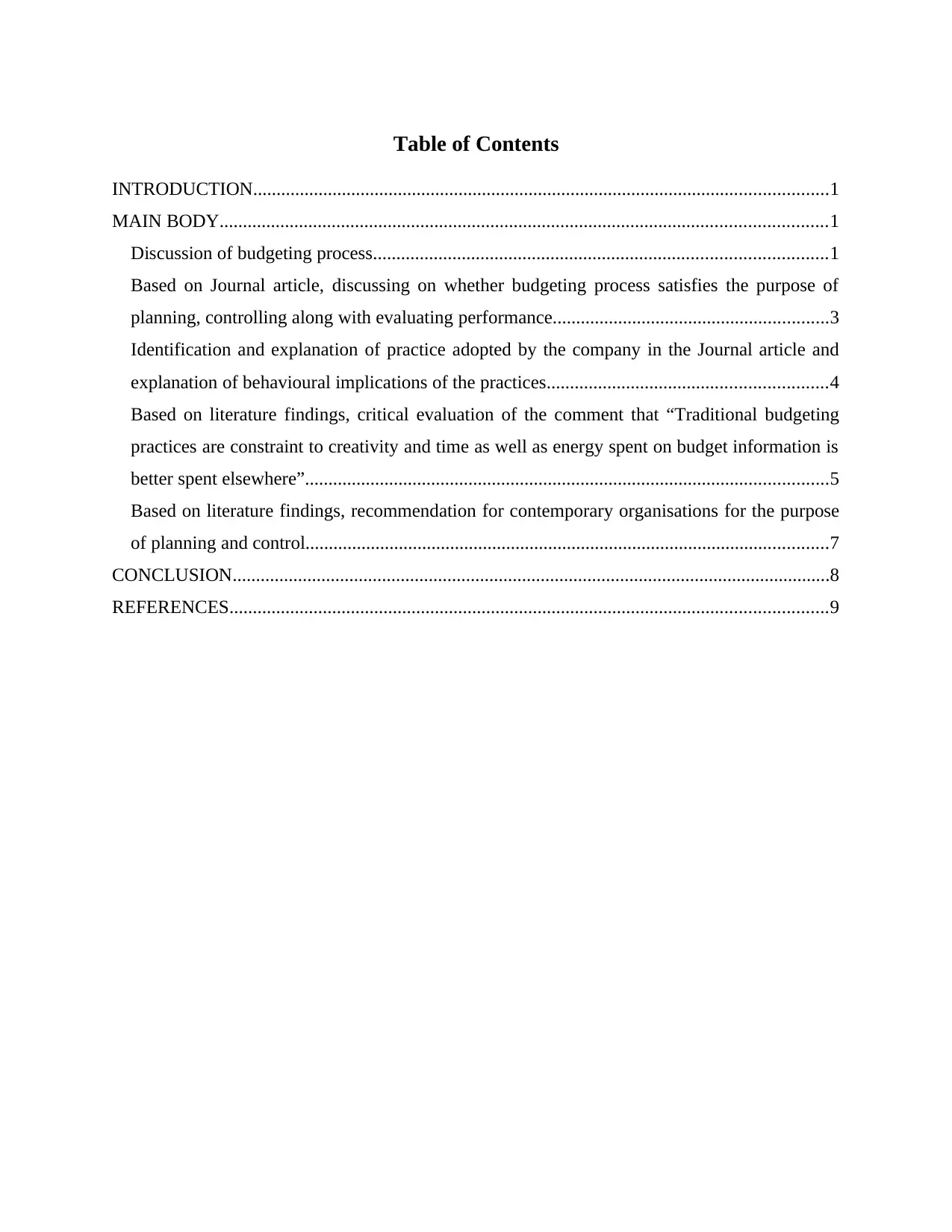
Table of Contents
INTRODUCTION...........................................................................................................................1
MAIN BODY..................................................................................................................................1
Discussion of budgeting process.................................................................................................1
Based on Journal article, discussing on whether budgeting process satisfies the purpose of
planning, controlling along with evaluating performance...........................................................3
Identification and explanation of practice adopted by the company in the Journal article and
explanation of behavioural implications of the practices............................................................4
Based on literature findings, critical evaluation of the comment that “Traditional budgeting
practices are constraint to creativity and time as well as energy spent on budget information is
better spent elsewhere”................................................................................................................5
Based on literature findings, recommendation for contemporary organisations for the purpose
of planning and control................................................................................................................7
CONCLUSION................................................................................................................................8
REFERENCES................................................................................................................................9
INTRODUCTION...........................................................................................................................1
MAIN BODY..................................................................................................................................1
Discussion of budgeting process.................................................................................................1
Based on Journal article, discussing on whether budgeting process satisfies the purpose of
planning, controlling along with evaluating performance...........................................................3
Identification and explanation of practice adopted by the company in the Journal article and
explanation of behavioural implications of the practices............................................................4
Based on literature findings, critical evaluation of the comment that “Traditional budgeting
practices are constraint to creativity and time as well as energy spent on budget information is
better spent elsewhere”................................................................................................................5
Based on literature findings, recommendation for contemporary organisations for the purpose
of planning and control................................................................................................................7
CONCLUSION................................................................................................................................8
REFERENCES................................................................................................................................9
⊘ This is a preview!⊘
Do you want full access?
Subscribe today to unlock all pages.

Trusted by 1+ million students worldwide
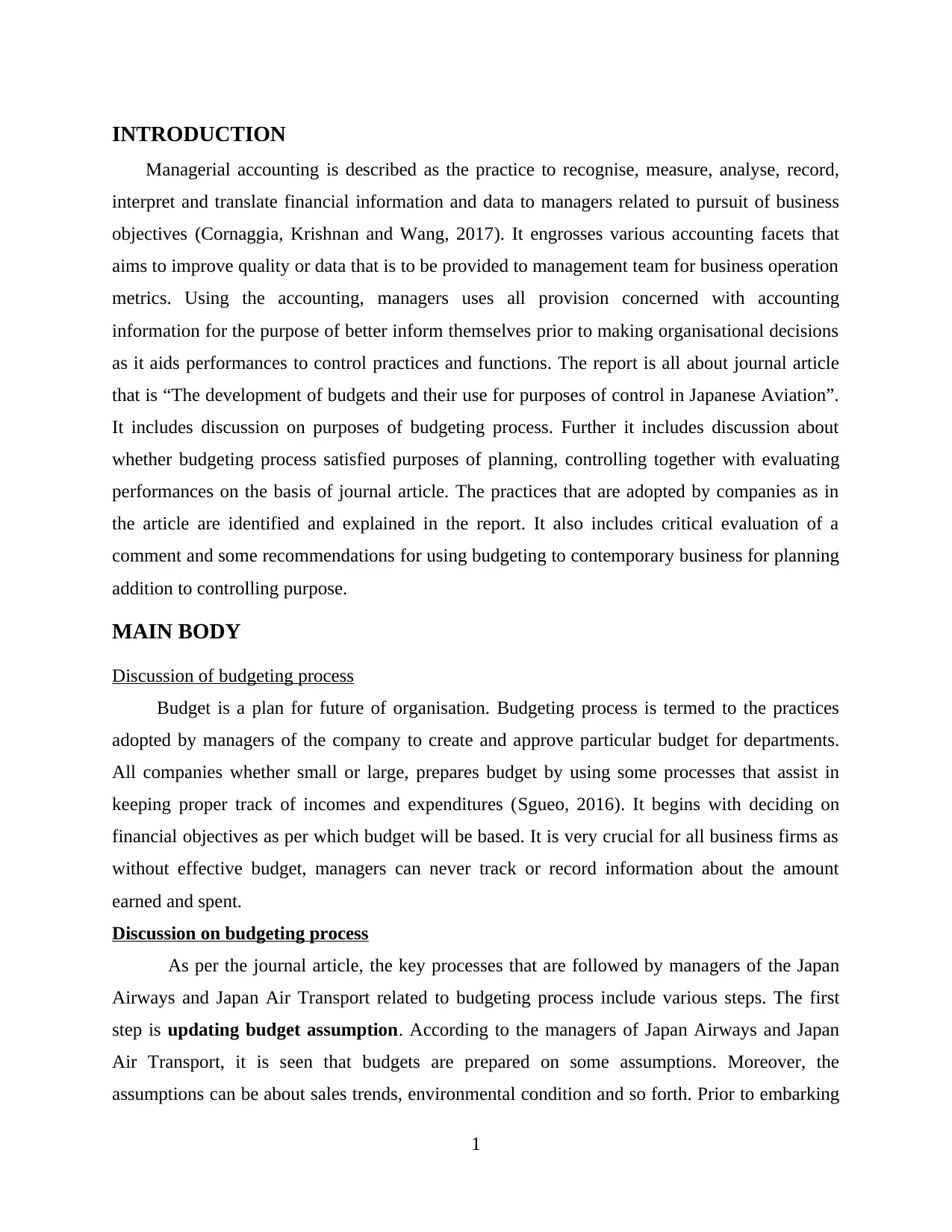
INTRODUCTION
Managerial accounting is described as the practice to recognise, measure, analyse, record,
interpret and translate financial information and data to managers related to pursuit of business
objectives (Cornaggia, Krishnan and Wang, 2017). It engrosses various accounting facets that
aims to improve quality or data that is to be provided to management team for business operation
metrics. Using the accounting, managers uses all provision concerned with accounting
information for the purpose of better inform themselves prior to making organisational decisions
as it aids performances to control practices and functions. The report is all about journal article
that is “The development of budgets and their use for purposes of control in Japanese Aviation”.
It includes discussion on purposes of budgeting process. Further it includes discussion about
whether budgeting process satisfied purposes of planning, controlling together with evaluating
performances on the basis of journal article. The practices that are adopted by companies as in
the article are identified and explained in the report. It also includes critical evaluation of a
comment and some recommendations for using budgeting to contemporary business for planning
addition to controlling purpose.
MAIN BODY
Discussion of budgeting process
Budget is a plan for future of organisation. Budgeting process is termed to the practices
adopted by managers of the company to create and approve particular budget for departments.
All companies whether small or large, prepares budget by using some processes that assist in
keeping proper track of incomes and expenditures (Sgueo, 2016). It begins with deciding on
financial objectives as per which budget will be based. It is very crucial for all business firms as
without effective budget, managers can never track or record information about the amount
earned and spent.
Discussion on budgeting process
As per the journal article, the key processes that are followed by managers of the Japan
Airways and Japan Air Transport related to budgeting process include various steps. The first
step is updating budget assumption. According to the managers of Japan Airways and Japan
Air Transport, it is seen that budgets are prepared on some assumptions. Moreover, the
assumptions can be about sales trends, environmental condition and so forth. Prior to embarking
1
Managerial accounting is described as the practice to recognise, measure, analyse, record,
interpret and translate financial information and data to managers related to pursuit of business
objectives (Cornaggia, Krishnan and Wang, 2017). It engrosses various accounting facets that
aims to improve quality or data that is to be provided to management team for business operation
metrics. Using the accounting, managers uses all provision concerned with accounting
information for the purpose of better inform themselves prior to making organisational decisions
as it aids performances to control practices and functions. The report is all about journal article
that is “The development of budgets and their use for purposes of control in Japanese Aviation”.
It includes discussion on purposes of budgeting process. Further it includes discussion about
whether budgeting process satisfied purposes of planning, controlling together with evaluating
performances on the basis of journal article. The practices that are adopted by companies as in
the article are identified and explained in the report. It also includes critical evaluation of a
comment and some recommendations for using budgeting to contemporary business for planning
addition to controlling purpose.
MAIN BODY
Discussion of budgeting process
Budget is a plan for future of organisation. Budgeting process is termed to the practices
adopted by managers of the company to create and approve particular budget for departments.
All companies whether small or large, prepares budget by using some processes that assist in
keeping proper track of incomes and expenditures (Sgueo, 2016). It begins with deciding on
financial objectives as per which budget will be based. It is very crucial for all business firms as
without effective budget, managers can never track or record information about the amount
earned and spent.
Discussion on budgeting process
As per the journal article, the key processes that are followed by managers of the Japan
Airways and Japan Air Transport related to budgeting process include various steps. The first
step is updating budget assumption. According to the managers of Japan Airways and Japan
Air Transport, it is seen that budgets are prepared on some assumptions. Moreover, the
assumptions can be about sales trends, environmental condition and so forth. Prior to embarking
1
Paraphrase This Document
Need a fresh take? Get an instant paraphrase of this document with our AI Paraphraser
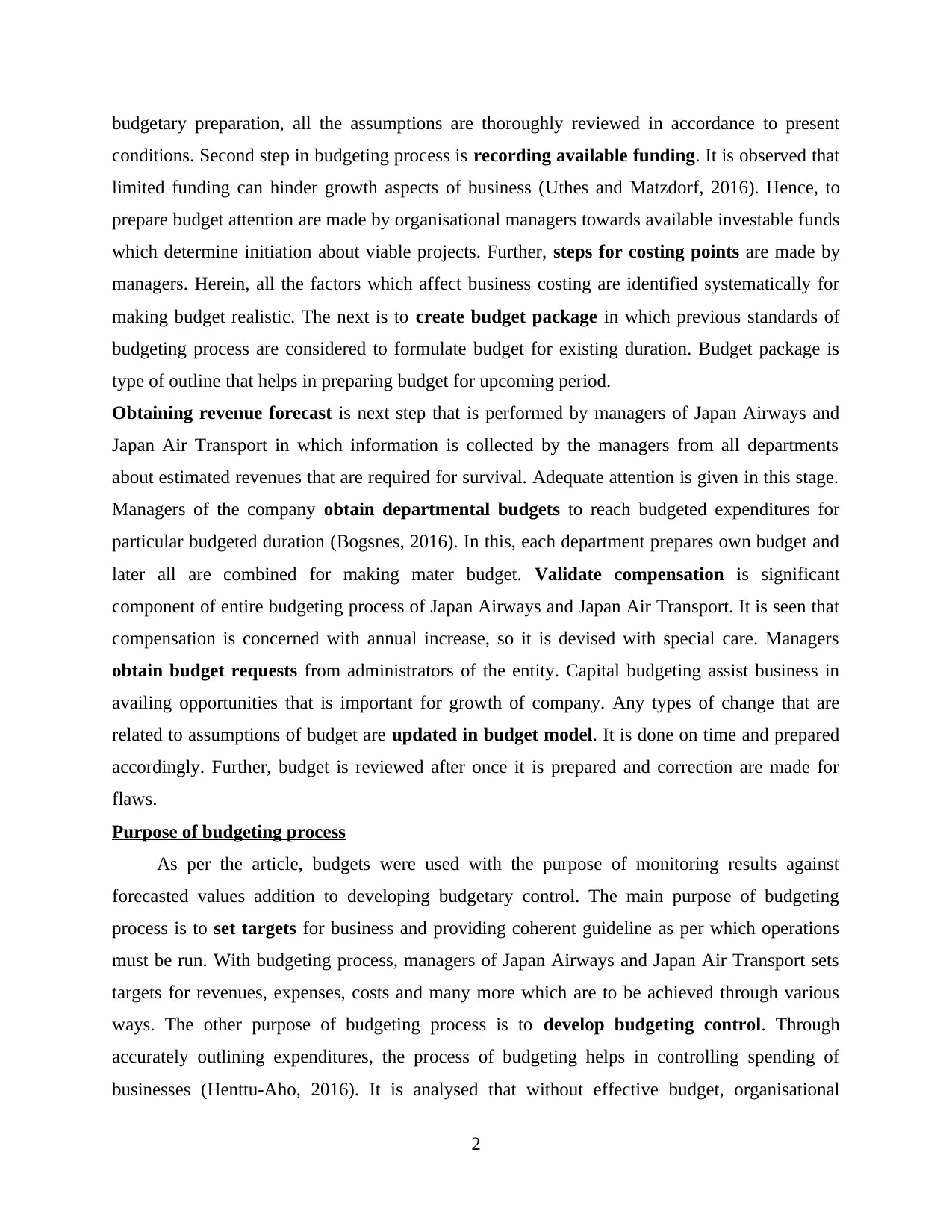
budgetary preparation, all the assumptions are thoroughly reviewed in accordance to present
conditions. Second step in budgeting process is recording available funding. It is observed that
limited funding can hinder growth aspects of business (Uthes and Matzdorf, 2016). Hence, to
prepare budget attention are made by organisational managers towards available investable funds
which determine initiation about viable projects. Further, steps for costing points are made by
managers. Herein, all the factors which affect business costing are identified systematically for
making budget realistic. The next is to create budget package in which previous standards of
budgeting process are considered to formulate budget for existing duration. Budget package is
type of outline that helps in preparing budget for upcoming period.
Obtaining revenue forecast is next step that is performed by managers of Japan Airways and
Japan Air Transport in which information is collected by the managers from all departments
about estimated revenues that are required for survival. Adequate attention is given in this stage.
Managers of the company obtain departmental budgets to reach budgeted expenditures for
particular budgeted duration (Bogsnes, 2016). In this, each department prepares own budget and
later all are combined for making mater budget. Validate compensation is significant
component of entire budgeting process of Japan Airways and Japan Air Transport. It is seen that
compensation is concerned with annual increase, so it is devised with special care. Managers
obtain budget requests from administrators of the entity. Capital budgeting assist business in
availing opportunities that is important for growth of company. Any types of change that are
related to assumptions of budget are updated in budget model. It is done on time and prepared
accordingly. Further, budget is reviewed after once it is prepared and correction are made for
flaws.
Purpose of budgeting process
As per the article, budgets were used with the purpose of monitoring results against
forecasted values addition to developing budgetary control. The main purpose of budgeting
process is to set targets for business and providing coherent guideline as per which operations
must be run. With budgeting process, managers of Japan Airways and Japan Air Transport sets
targets for revenues, expenses, costs and many more which are to be achieved through various
ways. The other purpose of budgeting process is to develop budgeting control. Through
accurately outlining expenditures, the process of budgeting helps in controlling spending of
businesses (Henttu-Aho, 2016). It is analysed that without effective budget, organisational
2
conditions. Second step in budgeting process is recording available funding. It is observed that
limited funding can hinder growth aspects of business (Uthes and Matzdorf, 2016). Hence, to
prepare budget attention are made by organisational managers towards available investable funds
which determine initiation about viable projects. Further, steps for costing points are made by
managers. Herein, all the factors which affect business costing are identified systematically for
making budget realistic. The next is to create budget package in which previous standards of
budgeting process are considered to formulate budget for existing duration. Budget package is
type of outline that helps in preparing budget for upcoming period.
Obtaining revenue forecast is next step that is performed by managers of Japan Airways and
Japan Air Transport in which information is collected by the managers from all departments
about estimated revenues that are required for survival. Adequate attention is given in this stage.
Managers of the company obtain departmental budgets to reach budgeted expenditures for
particular budgeted duration (Bogsnes, 2016). In this, each department prepares own budget and
later all are combined for making mater budget. Validate compensation is significant
component of entire budgeting process of Japan Airways and Japan Air Transport. It is seen that
compensation is concerned with annual increase, so it is devised with special care. Managers
obtain budget requests from administrators of the entity. Capital budgeting assist business in
availing opportunities that is important for growth of company. Any types of change that are
related to assumptions of budget are updated in budget model. It is done on time and prepared
accordingly. Further, budget is reviewed after once it is prepared and correction are made for
flaws.
Purpose of budgeting process
As per the article, budgets were used with the purpose of monitoring results against
forecasted values addition to developing budgetary control. The main purpose of budgeting
process is to set targets for business and providing coherent guideline as per which operations
must be run. With budgeting process, managers of Japan Airways and Japan Air Transport sets
targets for revenues, expenses, costs and many more which are to be achieved through various
ways. The other purpose of budgeting process is to develop budgeting control. Through
accurately outlining expenditures, the process of budgeting helps in controlling spending of
businesses (Henttu-Aho, 2016). It is analysed that without effective budget, organisational
2
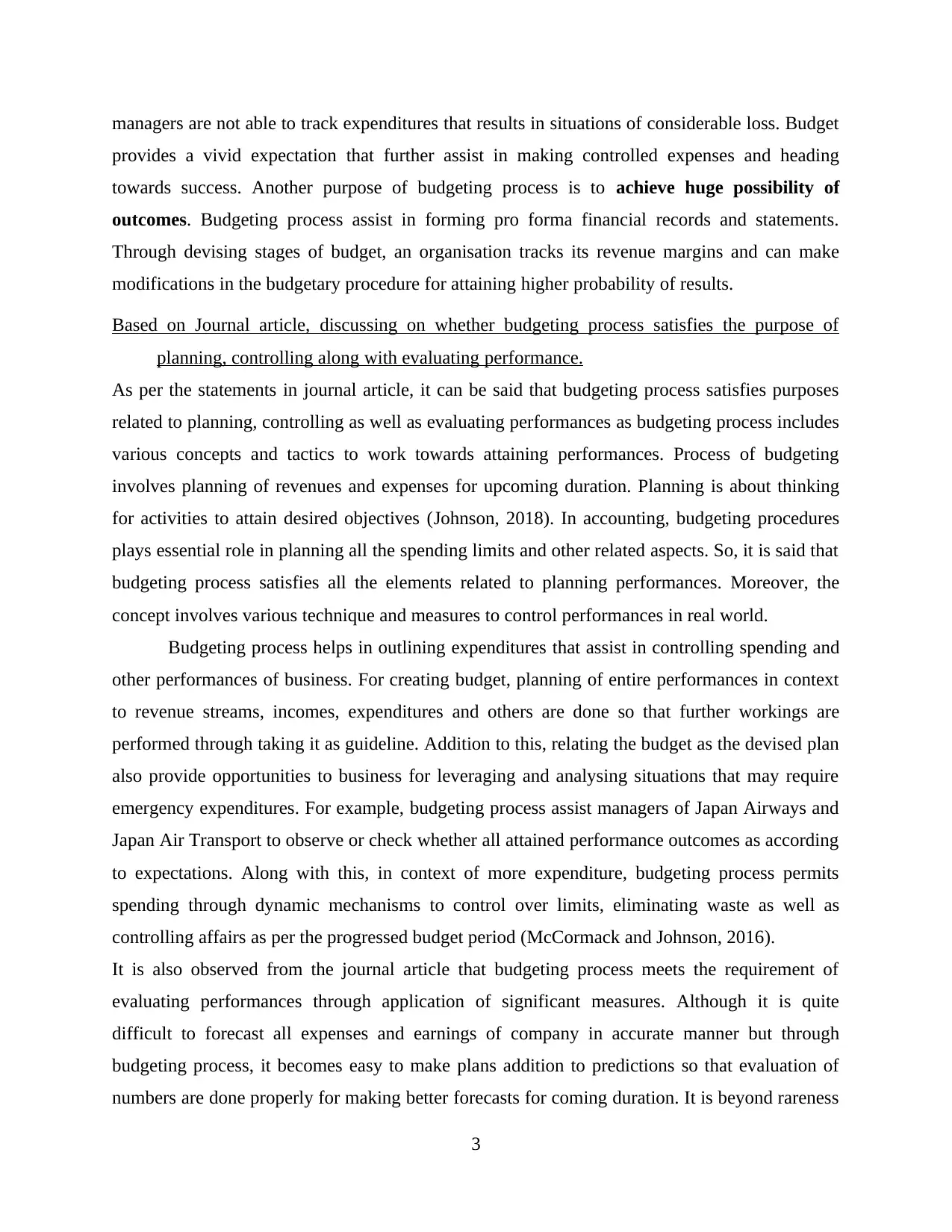
managers are not able to track expenditures that results in situations of considerable loss. Budget
provides a vivid expectation that further assist in making controlled expenses and heading
towards success. Another purpose of budgeting process is to achieve huge possibility of
outcomes. Budgeting process assist in forming pro forma financial records and statements.
Through devising stages of budget, an organisation tracks its revenue margins and can make
modifications in the budgetary procedure for attaining higher probability of results.
Based on Journal article, discussing on whether budgeting process satisfies the purpose of
planning, controlling along with evaluating performance.
As per the statements in journal article, it can be said that budgeting process satisfies purposes
related to planning, controlling as well as evaluating performances as budgeting process includes
various concepts and tactics to work towards attaining performances. Process of budgeting
involves planning of revenues and expenses for upcoming duration. Planning is about thinking
for activities to attain desired objectives (Johnson, 2018). In accounting, budgeting procedures
plays essential role in planning all the spending limits and other related aspects. So, it is said that
budgeting process satisfies all the elements related to planning performances. Moreover, the
concept involves various technique and measures to control performances in real world.
Budgeting process helps in outlining expenditures that assist in controlling spending and
other performances of business. For creating budget, planning of entire performances in context
to revenue streams, incomes, expenditures and others are done so that further workings are
performed through taking it as guideline. Addition to this, relating the budget as the devised plan
also provide opportunities to business for leveraging and analysing situations that may require
emergency expenditures. For example, budgeting process assist managers of Japan Airways and
Japan Air Transport to observe or check whether all attained performance outcomes as according
to expectations. Along with this, in context of more expenditure, budgeting process permits
spending through dynamic mechanisms to control over limits, eliminating waste as well as
controlling affairs as per the progressed budget period (McCormack and Johnson, 2016).
It is also observed from the journal article that budgeting process meets the requirement of
evaluating performances through application of significant measures. Although it is quite
difficult to forecast all expenses and earnings of company in accurate manner but through
budgeting process, it becomes easy to make plans addition to predictions so that evaluation of
numbers are done properly for making better forecasts for coming duration. It is beyond rareness
3
provides a vivid expectation that further assist in making controlled expenses and heading
towards success. Another purpose of budgeting process is to achieve huge possibility of
outcomes. Budgeting process assist in forming pro forma financial records and statements.
Through devising stages of budget, an organisation tracks its revenue margins and can make
modifications in the budgetary procedure for attaining higher probability of results.
Based on Journal article, discussing on whether budgeting process satisfies the purpose of
planning, controlling along with evaluating performance.
As per the statements in journal article, it can be said that budgeting process satisfies purposes
related to planning, controlling as well as evaluating performances as budgeting process includes
various concepts and tactics to work towards attaining performances. Process of budgeting
involves planning of revenues and expenses for upcoming duration. Planning is about thinking
for activities to attain desired objectives (Johnson, 2018). In accounting, budgeting procedures
plays essential role in planning all the spending limits and other related aspects. So, it is said that
budgeting process satisfies all the elements related to planning performances. Moreover, the
concept involves various technique and measures to control performances in real world.
Budgeting process helps in outlining expenditures that assist in controlling spending and
other performances of business. For creating budget, planning of entire performances in context
to revenue streams, incomes, expenditures and others are done so that further workings are
performed through taking it as guideline. Addition to this, relating the budget as the devised plan
also provide opportunities to business for leveraging and analysing situations that may require
emergency expenditures. For example, budgeting process assist managers of Japan Airways and
Japan Air Transport to observe or check whether all attained performance outcomes as according
to expectations. Along with this, in context of more expenditure, budgeting process permits
spending through dynamic mechanisms to control over limits, eliminating waste as well as
controlling affairs as per the progressed budget period (McCormack and Johnson, 2016).
It is also observed from the journal article that budgeting process meets the requirement of
evaluating performances through application of significant measures. Although it is quite
difficult to forecast all expenses and earnings of company in accurate manner but through
budgeting process, it becomes easy to make plans addition to predictions so that evaluation of
numbers are done properly for making better forecasts for coming duration. It is beyond rareness
3
⊘ This is a preview!⊘
Do you want full access?
Subscribe today to unlock all pages.

Trusted by 1+ million students worldwide
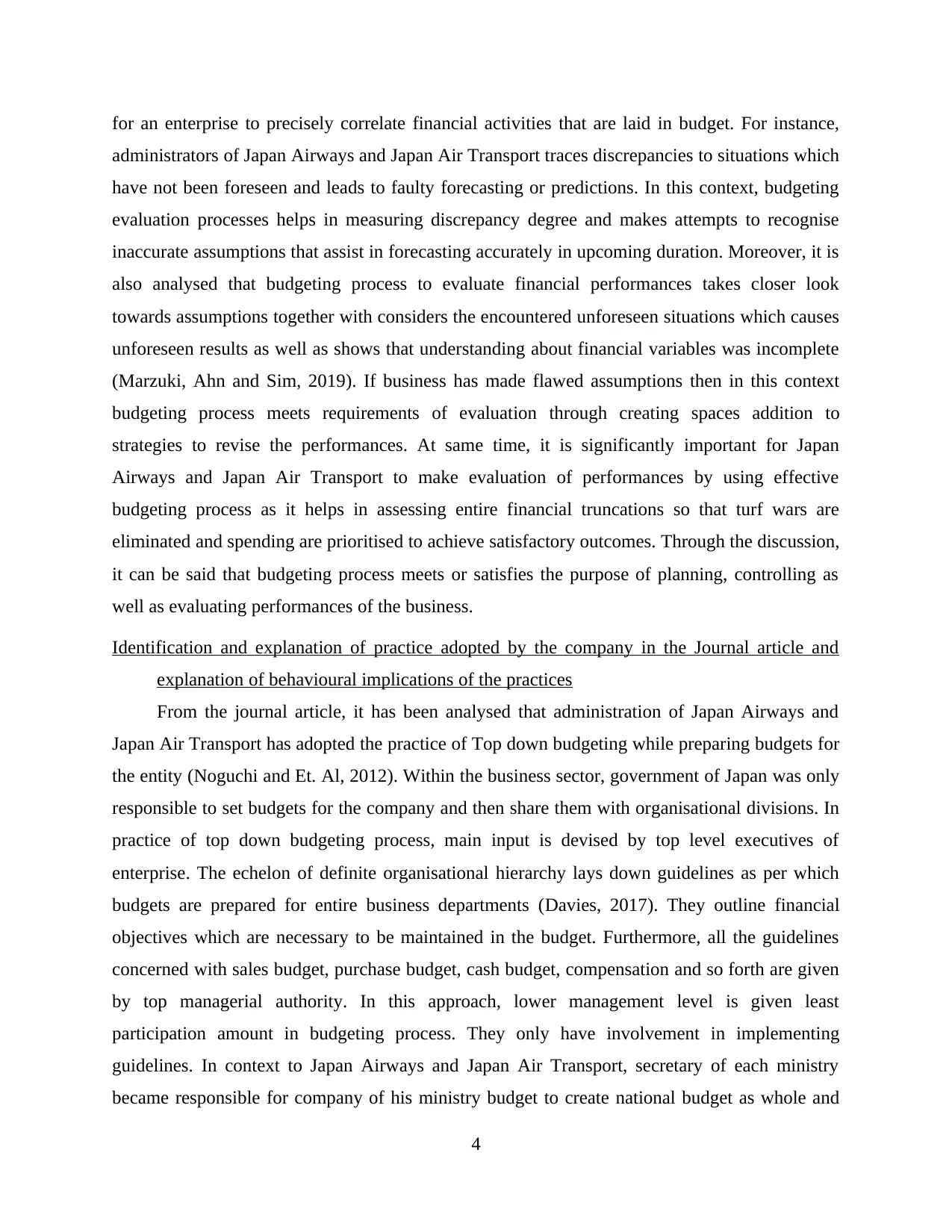
for an enterprise to precisely correlate financial activities that are laid in budget. For instance,
administrators of Japan Airways and Japan Air Transport traces discrepancies to situations which
have not been foreseen and leads to faulty forecasting or predictions. In this context, budgeting
evaluation processes helps in measuring discrepancy degree and makes attempts to recognise
inaccurate assumptions that assist in forecasting accurately in upcoming duration. Moreover, it is
also analysed that budgeting process to evaluate financial performances takes closer look
towards assumptions together with considers the encountered unforeseen situations which causes
unforeseen results as well as shows that understanding about financial variables was incomplete
(Marzuki, Ahn and Sim, 2019). If business has made flawed assumptions then in this context
budgeting process meets requirements of evaluation through creating spaces addition to
strategies to revise the performances. At same time, it is significantly important for Japan
Airways and Japan Air Transport to make evaluation of performances by using effective
budgeting process as it helps in assessing entire financial truncations so that turf wars are
eliminated and spending are prioritised to achieve satisfactory outcomes. Through the discussion,
it can be said that budgeting process meets or satisfies the purpose of planning, controlling as
well as evaluating performances of the business.
Identification and explanation of practice adopted by the company in the Journal article and
explanation of behavioural implications of the practices
From the journal article, it has been analysed that administration of Japan Airways and
Japan Air Transport has adopted the practice of Top down budgeting while preparing budgets for
the entity (Noguchi and Et. Al, 2012). Within the business sector, government of Japan was only
responsible to set budgets for the company and then share them with organisational divisions. In
practice of top down budgeting process, main input is devised by top level executives of
enterprise. The echelon of definite organisational hierarchy lays down guidelines as per which
budgets are prepared for entire business departments (Davies, 2017). They outline financial
objectives which are necessary to be maintained in the budget. Furthermore, all the guidelines
concerned with sales budget, purchase budget, cash budget, compensation and so forth are given
by top managerial authority. In this approach, lower management level is given least
participation amount in budgeting process. They only have involvement in implementing
guidelines. In context to Japan Airways and Japan Air Transport, secretary of each ministry
became responsible for company of his ministry budget to create national budget as whole and
4
administrators of Japan Airways and Japan Air Transport traces discrepancies to situations which
have not been foreseen and leads to faulty forecasting or predictions. In this context, budgeting
evaluation processes helps in measuring discrepancy degree and makes attempts to recognise
inaccurate assumptions that assist in forecasting accurately in upcoming duration. Moreover, it is
also analysed that budgeting process to evaluate financial performances takes closer look
towards assumptions together with considers the encountered unforeseen situations which causes
unforeseen results as well as shows that understanding about financial variables was incomplete
(Marzuki, Ahn and Sim, 2019). If business has made flawed assumptions then in this context
budgeting process meets requirements of evaluation through creating spaces addition to
strategies to revise the performances. At same time, it is significantly important for Japan
Airways and Japan Air Transport to make evaluation of performances by using effective
budgeting process as it helps in assessing entire financial truncations so that turf wars are
eliminated and spending are prioritised to achieve satisfactory outcomes. Through the discussion,
it can be said that budgeting process meets or satisfies the purpose of planning, controlling as
well as evaluating performances of the business.
Identification and explanation of practice adopted by the company in the Journal article and
explanation of behavioural implications of the practices
From the journal article, it has been analysed that administration of Japan Airways and
Japan Air Transport has adopted the practice of Top down budgeting while preparing budgets for
the entity (Noguchi and Et. Al, 2012). Within the business sector, government of Japan was only
responsible to set budgets for the company and then share them with organisational divisions. In
practice of top down budgeting process, main input is devised by top level executives of
enterprise. The echelon of definite organisational hierarchy lays down guidelines as per which
budgets are prepared for entire business departments (Davies, 2017). They outline financial
objectives which are necessary to be maintained in the budget. Furthermore, all the guidelines
concerned with sales budget, purchase budget, cash budget, compensation and so forth are given
by top managerial authority. In this approach, lower management level is given least
participation amount in budgeting process. They only have involvement in implementing
guidelines. In context to Japan Airways and Japan Air Transport, secretary of each ministry
became responsible for company of his ministry budget to create national budget as whole and
4
Paraphrase This Document
Need a fresh take? Get an instant paraphrase of this document with our AI Paraphraser
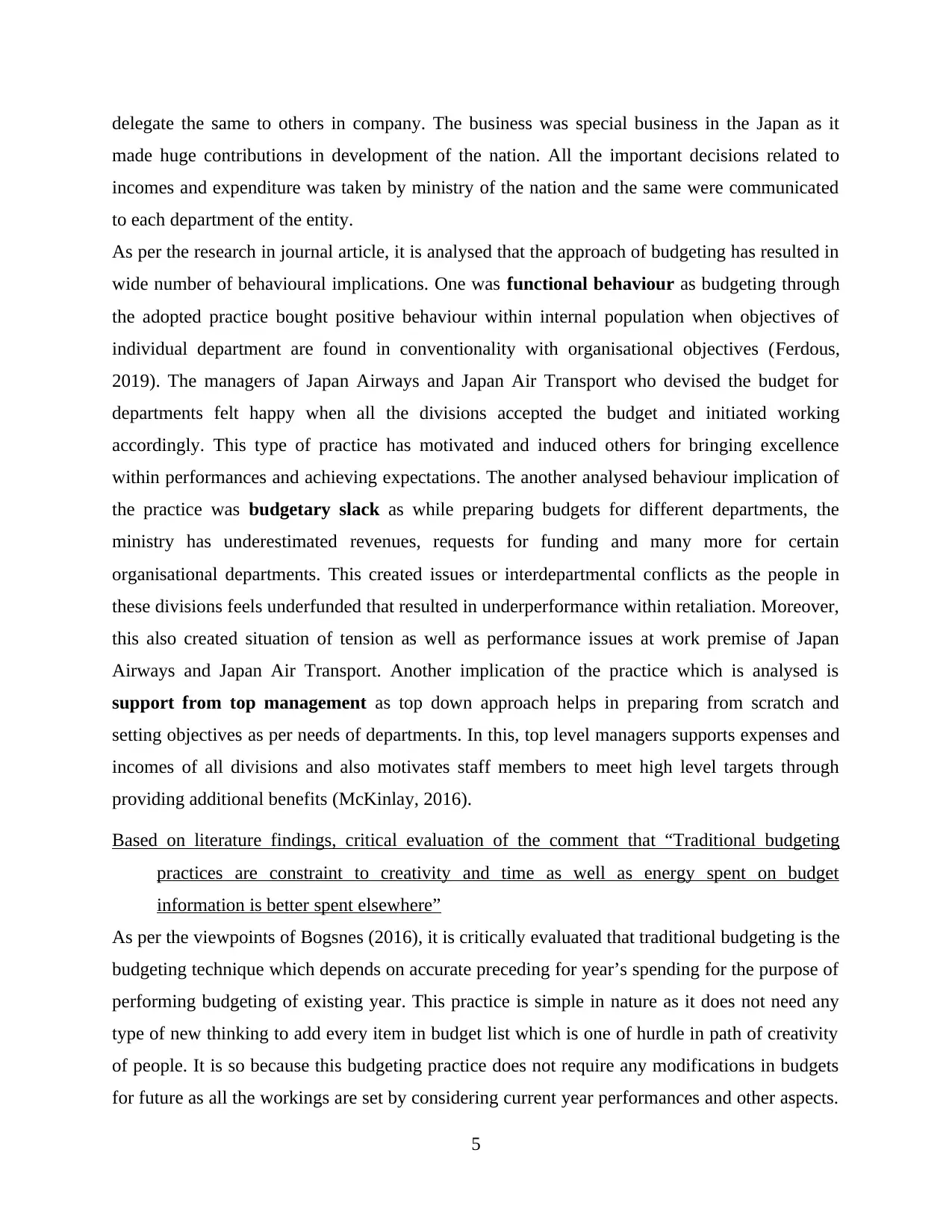
delegate the same to others in company. The business was special business in the Japan as it
made huge contributions in development of the nation. All the important decisions related to
incomes and expenditure was taken by ministry of the nation and the same were communicated
to each department of the entity.
As per the research in journal article, it is analysed that the approach of budgeting has resulted in
wide number of behavioural implications. One was functional behaviour as budgeting through
the adopted practice bought positive behaviour within internal population when objectives of
individual department are found in conventionality with organisational objectives (Ferdous,
2019). The managers of Japan Airways and Japan Air Transport who devised the budget for
departments felt happy when all the divisions accepted the budget and initiated working
accordingly. This type of practice has motivated and induced others for bringing excellence
within performances and achieving expectations. The another analysed behaviour implication of
the practice was budgetary slack as while preparing budgets for different departments, the
ministry has underestimated revenues, requests for funding and many more for certain
organisational departments. This created issues or interdepartmental conflicts as the people in
these divisions feels underfunded that resulted in underperformance within retaliation. Moreover,
this also created situation of tension as well as performance issues at work premise of Japan
Airways and Japan Air Transport. Another implication of the practice which is analysed is
support from top management as top down approach helps in preparing from scratch and
setting objectives as per needs of departments. In this, top level managers supports expenses and
incomes of all divisions and also motivates staff members to meet high level targets through
providing additional benefits (McKinlay, 2016).
Based on literature findings, critical evaluation of the comment that “Traditional budgeting
practices are constraint to creativity and time as well as energy spent on budget
information is better spent elsewhere”
As per the viewpoints of Bogsnes (2016), it is critically evaluated that traditional budgeting is the
budgeting technique which depends on accurate preceding for year’s spending for the purpose of
performing budgeting of existing year. This practice is simple in nature as it does not need any
type of new thinking to add every item in budget list which is one of hurdle in path of creativity
of people. It is so because this budgeting practice does not require any modifications in budgets
for future as all the workings are set by considering current year performances and other aspects.
5
made huge contributions in development of the nation. All the important decisions related to
incomes and expenditure was taken by ministry of the nation and the same were communicated
to each department of the entity.
As per the research in journal article, it is analysed that the approach of budgeting has resulted in
wide number of behavioural implications. One was functional behaviour as budgeting through
the adopted practice bought positive behaviour within internal population when objectives of
individual department are found in conventionality with organisational objectives (Ferdous,
2019). The managers of Japan Airways and Japan Air Transport who devised the budget for
departments felt happy when all the divisions accepted the budget and initiated working
accordingly. This type of practice has motivated and induced others for bringing excellence
within performances and achieving expectations. The another analysed behaviour implication of
the practice was budgetary slack as while preparing budgets for different departments, the
ministry has underestimated revenues, requests for funding and many more for certain
organisational departments. This created issues or interdepartmental conflicts as the people in
these divisions feels underfunded that resulted in underperformance within retaliation. Moreover,
this also created situation of tension as well as performance issues at work premise of Japan
Airways and Japan Air Transport. Another implication of the practice which is analysed is
support from top management as top down approach helps in preparing from scratch and
setting objectives as per needs of departments. In this, top level managers supports expenses and
incomes of all divisions and also motivates staff members to meet high level targets through
providing additional benefits (McKinlay, 2016).
Based on literature findings, critical evaluation of the comment that “Traditional budgeting
practices are constraint to creativity and time as well as energy spent on budget
information is better spent elsewhere”
As per the viewpoints of Bogsnes (2016), it is critically evaluated that traditional budgeting is the
budgeting technique which depends on accurate preceding for year’s spending for the purpose of
performing budgeting of existing year. This practice is simple in nature as it does not need any
type of new thinking to add every item in budget list which is one of hurdle in path of creativity
of people. It is so because this budgeting practice does not require any modifications in budgets
for future as all the workings are set by considering current year performances and other aspects.
5
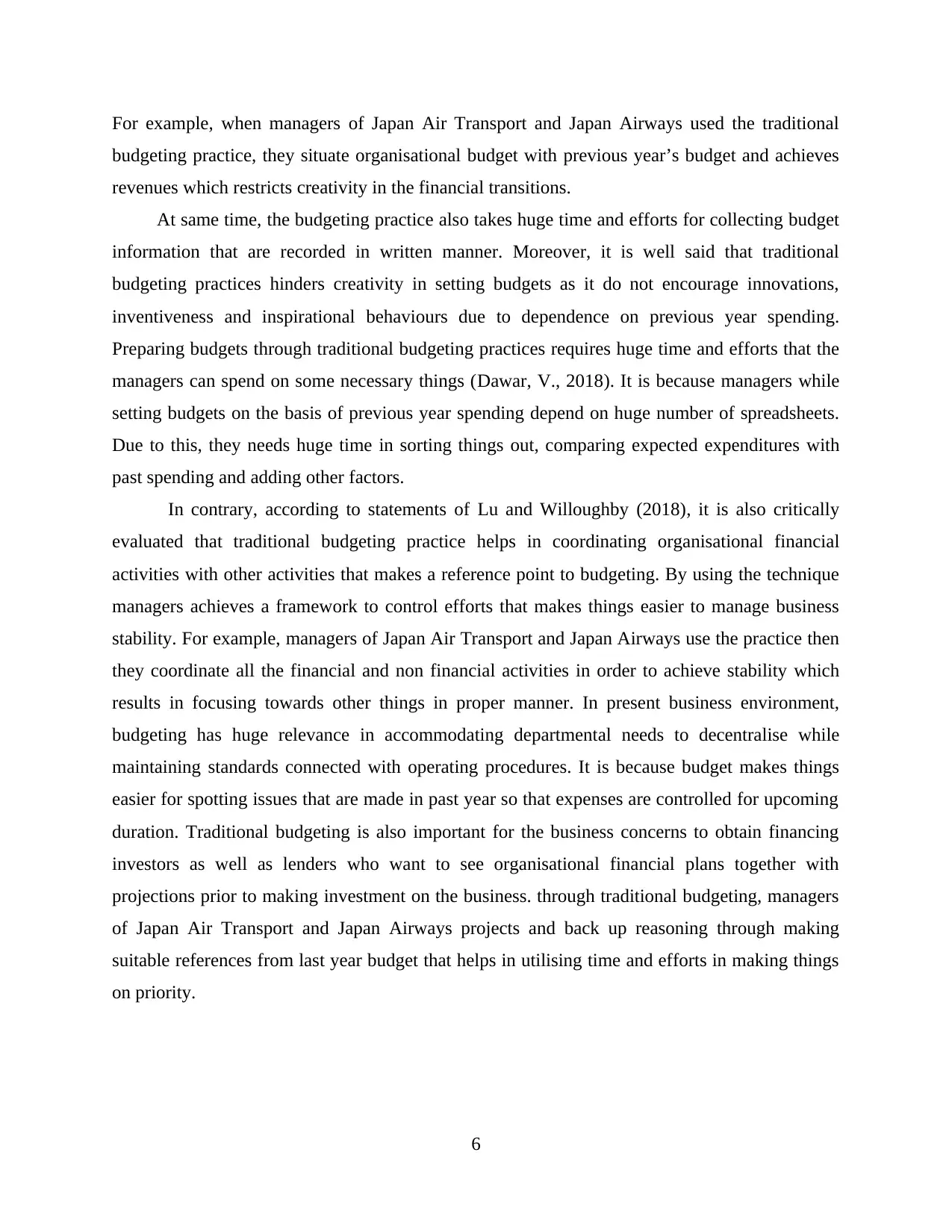
For example, when managers of Japan Air Transport and Japan Airways used the traditional
budgeting practice, they situate organisational budget with previous year’s budget and achieves
revenues which restricts creativity in the financial transitions.
At same time, the budgeting practice also takes huge time and efforts for collecting budget
information that are recorded in written manner. Moreover, it is well said that traditional
budgeting practices hinders creativity in setting budgets as it do not encourage innovations,
inventiveness and inspirational behaviours due to dependence on previous year spending.
Preparing budgets through traditional budgeting practices requires huge time and efforts that the
managers can spend on some necessary things (Dawar, V., 2018). It is because managers while
setting budgets on the basis of previous year spending depend on huge number of spreadsheets.
Due to this, they needs huge time in sorting things out, comparing expected expenditures with
past spending and adding other factors.
In contrary, according to statements of Lu and Willoughby (2018), it is also critically
evaluated that traditional budgeting practice helps in coordinating organisational financial
activities with other activities that makes a reference point to budgeting. By using the technique
managers achieves a framework to control efforts that makes things easier to manage business
stability. For example, managers of Japan Air Transport and Japan Airways use the practice then
they coordinate all the financial and non financial activities in order to achieve stability which
results in focusing towards other things in proper manner. In present business environment,
budgeting has huge relevance in accommodating departmental needs to decentralise while
maintaining standards connected with operating procedures. It is because budget makes things
easier for spotting issues that are made in past year so that expenses are controlled for upcoming
duration. Traditional budgeting is also important for the business concerns to obtain financing
investors as well as lenders who want to see organisational financial plans together with
projections prior to making investment on the business. through traditional budgeting, managers
of Japan Air Transport and Japan Airways projects and back up reasoning through making
suitable references from last year budget that helps in utilising time and efforts in making things
on priority.
6
budgeting practice, they situate organisational budget with previous year’s budget and achieves
revenues which restricts creativity in the financial transitions.
At same time, the budgeting practice also takes huge time and efforts for collecting budget
information that are recorded in written manner. Moreover, it is well said that traditional
budgeting practices hinders creativity in setting budgets as it do not encourage innovations,
inventiveness and inspirational behaviours due to dependence on previous year spending.
Preparing budgets through traditional budgeting practices requires huge time and efforts that the
managers can spend on some necessary things (Dawar, V., 2018). It is because managers while
setting budgets on the basis of previous year spending depend on huge number of spreadsheets.
Due to this, they needs huge time in sorting things out, comparing expected expenditures with
past spending and adding other factors.
In contrary, according to statements of Lu and Willoughby (2018), it is also critically
evaluated that traditional budgeting practice helps in coordinating organisational financial
activities with other activities that makes a reference point to budgeting. By using the technique
managers achieves a framework to control efforts that makes things easier to manage business
stability. For example, managers of Japan Air Transport and Japan Airways use the practice then
they coordinate all the financial and non financial activities in order to achieve stability which
results in focusing towards other things in proper manner. In present business environment,
budgeting has huge relevance in accommodating departmental needs to decentralise while
maintaining standards connected with operating procedures. It is because budget makes things
easier for spotting issues that are made in past year so that expenses are controlled for upcoming
duration. Traditional budgeting is also important for the business concerns to obtain financing
investors as well as lenders who want to see organisational financial plans together with
projections prior to making investment on the business. through traditional budgeting, managers
of Japan Air Transport and Japan Airways projects and back up reasoning through making
suitable references from last year budget that helps in utilising time and efforts in making things
on priority.
6
⊘ This is a preview!⊘
Do you want full access?
Subscribe today to unlock all pages.

Trusted by 1+ million students worldwide
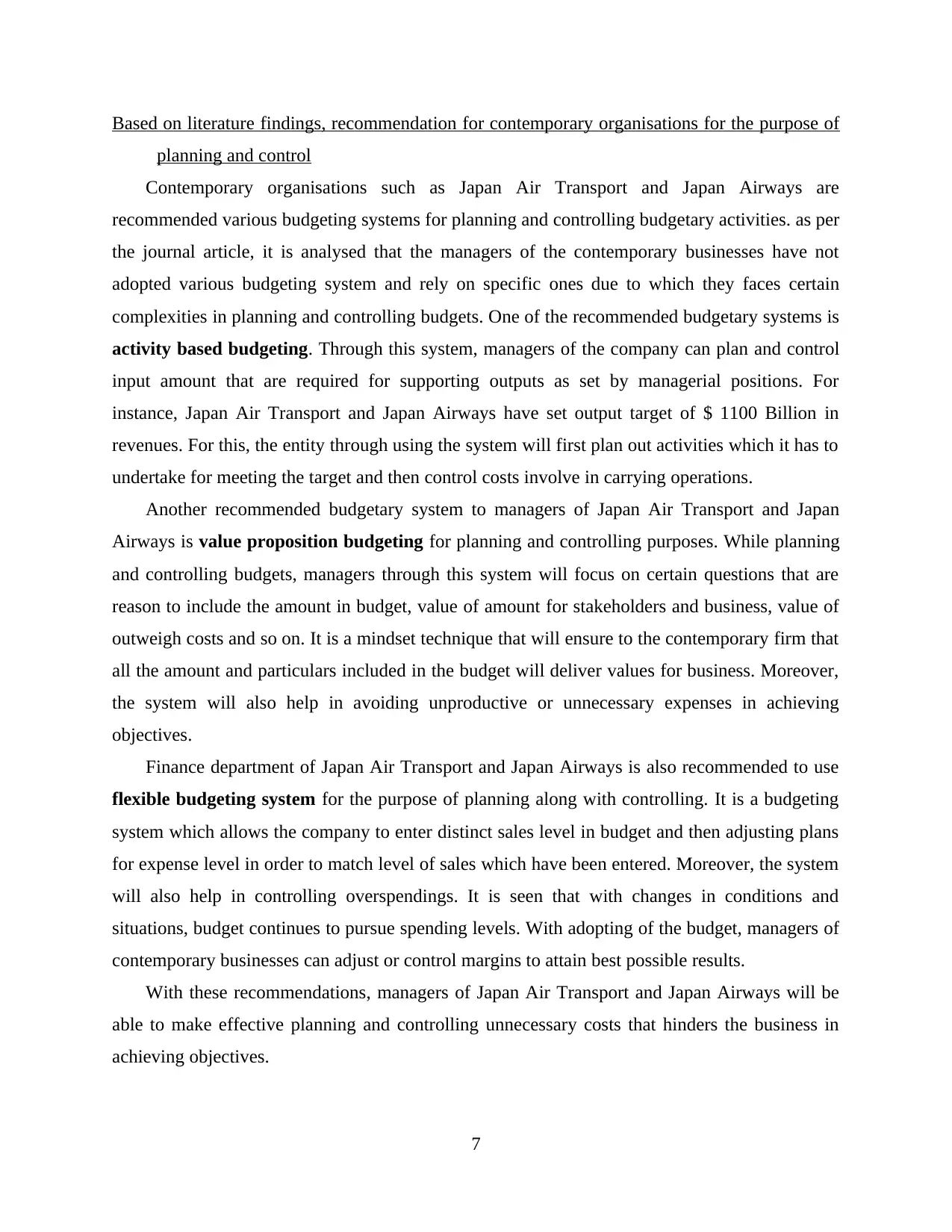
Based on literature findings, recommendation for contemporary organisations for the purpose of
planning and control
Contemporary organisations such as Japan Air Transport and Japan Airways are
recommended various budgeting systems for planning and controlling budgetary activities. as per
the journal article, it is analysed that the managers of the contemporary businesses have not
adopted various budgeting system and rely on specific ones due to which they faces certain
complexities in planning and controlling budgets. One of the recommended budgetary systems is
activity based budgeting. Through this system, managers of the company can plan and control
input amount that are required for supporting outputs as set by managerial positions. For
instance, Japan Air Transport and Japan Airways have set output target of $ 1100 Billion in
revenues. For this, the entity through using the system will first plan out activities which it has to
undertake for meeting the target and then control costs involve in carrying operations.
Another recommended budgetary system to managers of Japan Air Transport and Japan
Airways is value proposition budgeting for planning and controlling purposes. While planning
and controlling budgets, managers through this system will focus on certain questions that are
reason to include the amount in budget, value of amount for stakeholders and business, value of
outweigh costs and so on. It is a mindset technique that will ensure to the contemporary firm that
all the amount and particulars included in the budget will deliver values for business. Moreover,
the system will also help in avoiding unproductive or unnecessary expenses in achieving
objectives.
Finance department of Japan Air Transport and Japan Airways is also recommended to use
flexible budgeting system for the purpose of planning along with controlling. It is a budgeting
system which allows the company to enter distinct sales level in budget and then adjusting plans
for expense level in order to match level of sales which have been entered. Moreover, the system
will also help in controlling overspendings. It is seen that with changes in conditions and
situations, budget continues to pursue spending levels. With adopting of the budget, managers of
contemporary businesses can adjust or control margins to attain best possible results.
With these recommendations, managers of Japan Air Transport and Japan Airways will be
able to make effective planning and controlling unnecessary costs that hinders the business in
achieving objectives.
7
planning and control
Contemporary organisations such as Japan Air Transport and Japan Airways are
recommended various budgeting systems for planning and controlling budgetary activities. as per
the journal article, it is analysed that the managers of the contemporary businesses have not
adopted various budgeting system and rely on specific ones due to which they faces certain
complexities in planning and controlling budgets. One of the recommended budgetary systems is
activity based budgeting. Through this system, managers of the company can plan and control
input amount that are required for supporting outputs as set by managerial positions. For
instance, Japan Air Transport and Japan Airways have set output target of $ 1100 Billion in
revenues. For this, the entity through using the system will first plan out activities which it has to
undertake for meeting the target and then control costs involve in carrying operations.
Another recommended budgetary system to managers of Japan Air Transport and Japan
Airways is value proposition budgeting for planning and controlling purposes. While planning
and controlling budgets, managers through this system will focus on certain questions that are
reason to include the amount in budget, value of amount for stakeholders and business, value of
outweigh costs and so on. It is a mindset technique that will ensure to the contemporary firm that
all the amount and particulars included in the budget will deliver values for business. Moreover,
the system will also help in avoiding unproductive or unnecessary expenses in achieving
objectives.
Finance department of Japan Air Transport and Japan Airways is also recommended to use
flexible budgeting system for the purpose of planning along with controlling. It is a budgeting
system which allows the company to enter distinct sales level in budget and then adjusting plans
for expense level in order to match level of sales which have been entered. Moreover, the system
will also help in controlling overspendings. It is seen that with changes in conditions and
situations, budget continues to pursue spending levels. With adopting of the budget, managers of
contemporary businesses can adjust or control margins to attain best possible results.
With these recommendations, managers of Japan Air Transport and Japan Airways will be
able to make effective planning and controlling unnecessary costs that hinders the business in
achieving objectives.
7
Paraphrase This Document
Need a fresh take? Get an instant paraphrase of this document with our AI Paraphraser
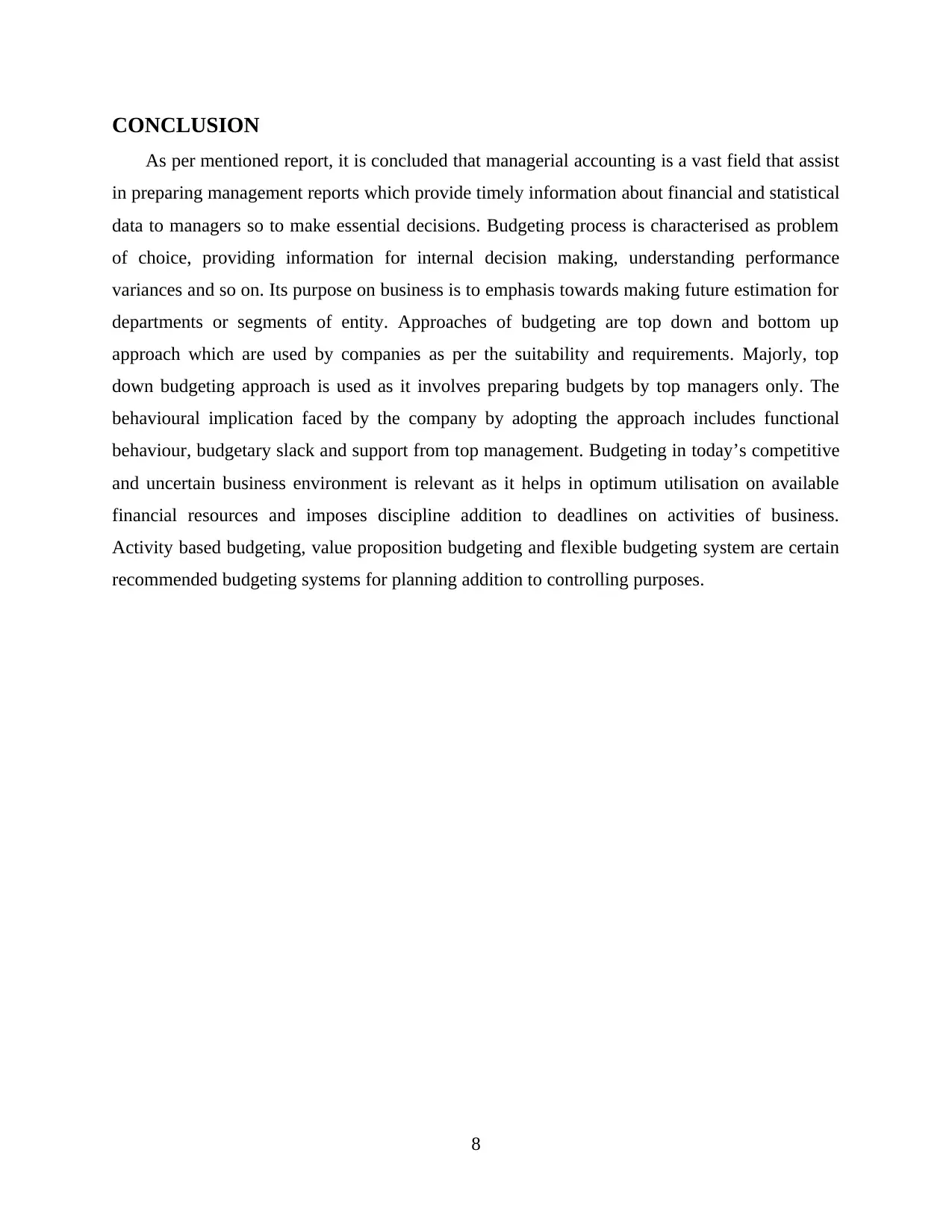
CONCLUSION
As per mentioned report, it is concluded that managerial accounting is a vast field that assist
in preparing management reports which provide timely information about financial and statistical
data to managers so to make essential decisions. Budgeting process is characterised as problem
of choice, providing information for internal decision making, understanding performance
variances and so on. Its purpose on business is to emphasis towards making future estimation for
departments or segments of entity. Approaches of budgeting are top down and bottom up
approach which are used by companies as per the suitability and requirements. Majorly, top
down budgeting approach is used as it involves preparing budgets by top managers only. The
behavioural implication faced by the company by adopting the approach includes functional
behaviour, budgetary slack and support from top management. Budgeting in today’s competitive
and uncertain business environment is relevant as it helps in optimum utilisation on available
financial resources and imposes discipline addition to deadlines on activities of business.
Activity based budgeting, value proposition budgeting and flexible budgeting system are certain
recommended budgeting systems for planning addition to controlling purposes.
8
As per mentioned report, it is concluded that managerial accounting is a vast field that assist
in preparing management reports which provide timely information about financial and statistical
data to managers so to make essential decisions. Budgeting process is characterised as problem
of choice, providing information for internal decision making, understanding performance
variances and so on. Its purpose on business is to emphasis towards making future estimation for
departments or segments of entity. Approaches of budgeting are top down and bottom up
approach which are used by companies as per the suitability and requirements. Majorly, top
down budgeting approach is used as it involves preparing budgets by top managers only. The
behavioural implication faced by the company by adopting the approach includes functional
behaviour, budgetary slack and support from top management. Budgeting in today’s competitive
and uncertain business environment is relevant as it helps in optimum utilisation on available
financial resources and imposes discipline addition to deadlines on activities of business.
Activity based budgeting, value proposition budgeting and flexible budgeting system are certain
recommended budgeting systems for planning addition to controlling purposes.
8
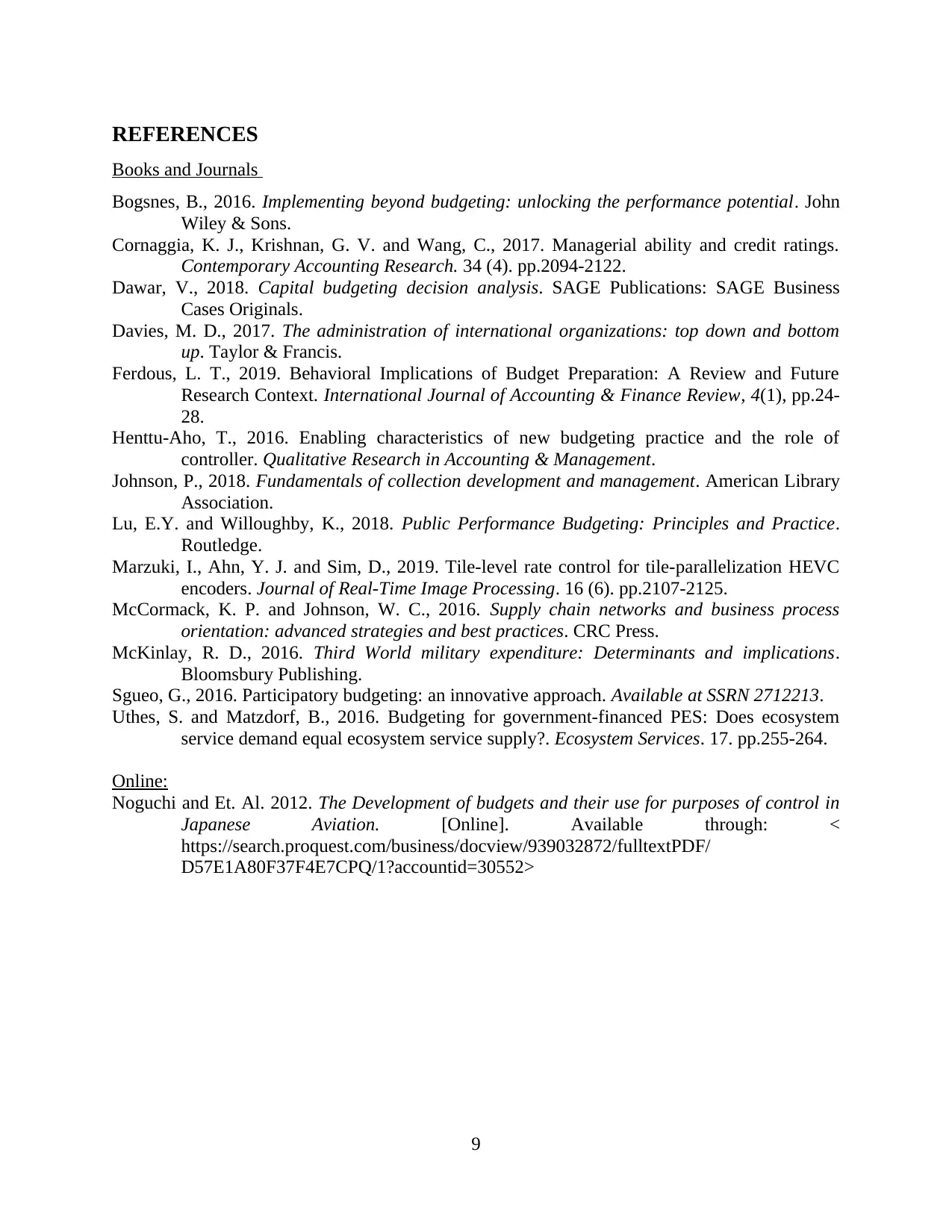
REFERENCES
Books and Journals
Bogsnes, B., 2016. Implementing beyond budgeting: unlocking the performance potential. John
Wiley & Sons.
Cornaggia, K. J., Krishnan, G. V. and Wang, C., 2017. Managerial ability and credit ratings.
Contemporary Accounting Research. 34 (4). pp.2094-2122.
Dawar, V., 2018. Capital budgeting decision analysis. SAGE Publications: SAGE Business
Cases Originals.
Davies, M. D., 2017. The administration of international organizations: top down and bottom
up. Taylor & Francis.
Ferdous, L. T., 2019. Behavioral Implications of Budget Preparation: A Review and Future
Research Context. International Journal of Accounting & Finance Review, 4(1), pp.24-
28.
Henttu-Aho, T., 2016. Enabling characteristics of new budgeting practice and the role of
controller. Qualitative Research in Accounting & Management.
Johnson, P., 2018. Fundamentals of collection development and management. American Library
Association.
Lu, E.Y. and Willoughby, K., 2018. Public Performance Budgeting: Principles and Practice.
Routledge.
Marzuki, I., Ahn, Y. J. and Sim, D., 2019. Tile-level rate control for tile-parallelization HEVC
encoders. Journal of Real-Time Image Processing. 16 (6). pp.2107-2125.
McCormack, K. P. and Johnson, W. C., 2016. Supply chain networks and business process
orientation: advanced strategies and best practices. CRC Press.
McKinlay, R. D., 2016. Third World military expenditure: Determinants and implications.
Bloomsbury Publishing.
Sgueo, G., 2016. Participatory budgeting: an innovative approach. Available at SSRN 2712213.
Uthes, S. and Matzdorf, B., 2016. Budgeting for government-financed PES: Does ecosystem
service demand equal ecosystem service supply?. Ecosystem Services. 17. pp.255-264.
Online:
Noguchi and Et. Al. 2012. The Development of budgets and their use for purposes of control in
Japanese Aviation. [Online]. Available through: <
https://search.proquest.com/business/docview/939032872/fulltextPDF/
D57E1A80F37F4E7CPQ/1?accountid=30552>
9
Books and Journals
Bogsnes, B., 2016. Implementing beyond budgeting: unlocking the performance potential. John
Wiley & Sons.
Cornaggia, K. J., Krishnan, G. V. and Wang, C., 2017. Managerial ability and credit ratings.
Contemporary Accounting Research. 34 (4). pp.2094-2122.
Dawar, V., 2018. Capital budgeting decision analysis. SAGE Publications: SAGE Business
Cases Originals.
Davies, M. D., 2017. The administration of international organizations: top down and bottom
up. Taylor & Francis.
Ferdous, L. T., 2019. Behavioral Implications of Budget Preparation: A Review and Future
Research Context. International Journal of Accounting & Finance Review, 4(1), pp.24-
28.
Henttu-Aho, T., 2016. Enabling characteristics of new budgeting practice and the role of
controller. Qualitative Research in Accounting & Management.
Johnson, P., 2018. Fundamentals of collection development and management. American Library
Association.
Lu, E.Y. and Willoughby, K., 2018. Public Performance Budgeting: Principles and Practice.
Routledge.
Marzuki, I., Ahn, Y. J. and Sim, D., 2019. Tile-level rate control for tile-parallelization HEVC
encoders. Journal of Real-Time Image Processing. 16 (6). pp.2107-2125.
McCormack, K. P. and Johnson, W. C., 2016. Supply chain networks and business process
orientation: advanced strategies and best practices. CRC Press.
McKinlay, R. D., 2016. Third World military expenditure: Determinants and implications.
Bloomsbury Publishing.
Sgueo, G., 2016. Participatory budgeting: an innovative approach. Available at SSRN 2712213.
Uthes, S. and Matzdorf, B., 2016. Budgeting for government-financed PES: Does ecosystem
service demand equal ecosystem service supply?. Ecosystem Services. 17. pp.255-264.
Online:
Noguchi and Et. Al. 2012. The Development of budgets and their use for purposes of control in
Japanese Aviation. [Online]. Available through: <
https://search.proquest.com/business/docview/939032872/fulltextPDF/
D57E1A80F37F4E7CPQ/1?accountid=30552>
9
⊘ This is a preview!⊘
Do you want full access?
Subscribe today to unlock all pages.

Trusted by 1+ million students worldwide
1 out of 12
Related Documents
Your All-in-One AI-Powered Toolkit for Academic Success.
+13062052269
info@desklib.com
Available 24*7 on WhatsApp / Email
![[object Object]](/_next/static/media/star-bottom.7253800d.svg)
Unlock your academic potential
Copyright © 2020–2025 A2Z Services. All Rights Reserved. Developed and managed by ZUCOL.





